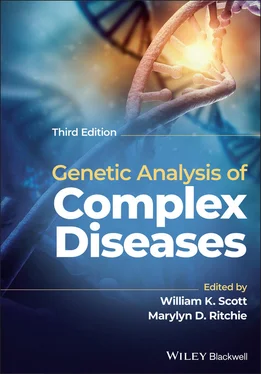Genetic Analysis of Complex Disease
Здесь есть возможность читать онлайн «Genetic Analysis of Complex Disease» — ознакомительный отрывок электронной книги совершенно бесплатно, а после прочтения отрывка купить полную версию. В некоторых случаях можно слушать аудио, скачать через торрент в формате fb2 и присутствует краткое содержание. Жанр: unrecognised, на английском языке. Описание произведения, (предисловие) а так же отзывы посетителей доступны на портале библиотеки ЛибКат.
- Название:Genetic Analysis of Complex Disease
- Автор:
- Жанр:
- Год:неизвестен
- ISBN:нет данных
- Рейтинг книги:4 / 5. Голосов: 1
-
Избранное:Добавить в избранное
- Отзывы:
-
Ваша оценка:
- 80
- 1
- 2
- 3
- 4
- 5
Genetic Analysis of Complex Disease: краткое содержание, описание и аннотация
Предлагаем к чтению аннотацию, описание, краткое содержание или предисловие (зависит от того, что написал сам автор книги «Genetic Analysis of Complex Disease»). Если вы не нашли необходимую информацию о книге — напишите в комментариях, мы постараемся отыскать её.
An up-to-date and complete treatment of the strategies, designs and analysis methods for studying complex genetic disease in human beings Genetic Analysis of Complex Diseases
Genetic Analysis of Complex Diseases
Genetic Analysis of Complex Diseases
Genetic Analysis of Complex Disease — читать онлайн ознакомительный отрывок
Ниже представлен текст книги, разбитый по страницам. Система сохранения места последней прочитанной страницы, позволяет с удобством читать онлайн бесплатно книгу «Genetic Analysis of Complex Disease», без необходимости каждый раз заново искать на чём Вы остановились. Поставьте закладку, и сможете в любой момент перейти на страницу, на которой закончили чтение.
Интервал:
Закладка:
56 Martin, E.R., Menold, M.M., Wolpert, C.M. et al. (2000a). Analysis of linkage disequilibrium in γ‐aminobutyric acid receptor subunit genes in autistic disorder. Am. J. Med. Genet. 96: 43–48.
57 Martin, E.R., Monks, S.A., Warren, L.L., and Kaplan, N.L. (2000b). A test for linkage and association in general pedigrees: the pedigree disequilibrium test. Am. J. Hum. Genet. 67: 146–154.
58 McCarthy, M.I., Kruglyak, L., and Lander, E.S. (1998). Sib‐pair collection strategies for complex diseases. Genet. Epidemiol. 15: 317–340.
59 Meadows, K.L., Pettay, D., Newman, J. et al. (1996). Survey of the fragile X syndrome and the fragile XE syndrome in a special education needs population. Am. J. Med. Genet. 64: 428–433.
60 Menold, M.M., Bass, M.P., Gilbert, J.R. et al. (2000). SNP analysis of GABAA receptor subunit in autistic disorder. Am. J. Hum. Genet. 67 (339): 1886A.
61 Meola, G. (2013). Clinical aspects, molecular pathomechanisms and management of myotonic dystrophies. Acta Myol. 32: 154–165.
62 Miettinen, O.S. (1974). Proportion of disease caused or prevented by a given exposure, trait or intervention. Am. J. Epidemiol. 99: 325–332.
63 Morton, N.E. (1982). Segregation and linkage analysis. In: Human Genetics, Part B: Medical Aspects (eds. B. Bonne‐Tamir, T. Cohen and R.M. Goodman), 3–14. Alan R. Liss.
64 Morton, N.E. and MacLean, C.J. (1974). Analysis of family resemblance. 3. Complex segregation of quantitative traits. Am. J. Hum. Genet. 26: 489–503.
65 Neel, J.V. (1949). The inheritance of sickle cell anemia. Science 110: 64–66.
66 Nestadt, G., Lan, T., Samuels, J. et al. (2000). Complex segregation analysis provides compelling evidence for a major gene underlying obsessive‐compulsive disorder and for heterogeneity by sex. Am. J. Hum. Genet. 67: 1611–1616.
67 Notarnicola, M., Cavallini, A., Cardone, R. et al. (2000). K‐ras and p53 mutations in DNA extracted from colonic epithelial cells exfoliated in faeces of patients with colorectal cancer. Dig. Liver Dis. 32: 131–136.
68 Penrose, L.S. (1948). The problem of anticipation in pedigrees of dystrophia myotonica. Ann. Eugenics 14: 125–132.
69 Philippe, A., Martinez, M., Guilloud‐Bataille, M. et al. (1999). Genome‐wide scan for autism susceptibility genes. Hum. Mol. Genet. 8: 805–812.
70 Piegorsch, W.W., Weinberg, C.R., and Taylor, J.A. (1994). Non‐hierarchical logistic models and case‐only designs for assessing susceptibility in population‐based case‐control studies. Stat. Med. 13: 153–162.
71 Rice, T., Despres, J.P., Daw, E.W. et al. (1997). Familial resemblance for abdominal visceral fat: the HERITAGE family study. Int. J. Obes. Relat. Metab. Disord. 21: 1024–1031.
72 Risch, N. (1990a). Linkage strategies for genetically complex traits. I. Multilocus models. Am. J. Hum. Genet. 46: 222–228.
73 Risch, N. (1990b). Linkage strategies for genetically complex traits. II. The power of affected relative pairs. Am. J. Hum. Genet. 46: 229–241.
74 Risch, N. (1990c). Linkage strategies for genetically complex traits. III. The effect of marker polymorphism on analysis of affected relative pairs. Am. J. Hum. Genet. 46: 242–253.
75 Roses, A.D., Devlin, B., Conneally, P.M. et al. (1995). Measuring the genetic contribution of APOE in late‐onset Alzheimer disease (AD). Am. J. Hum. Genet. 57: A202.
76 Rothman, K.J. and Greenland, S. (1998). Modern Epidemiology. Philadelphia, PA: Lippincott‐Raven.
77 Rousseau, F., Heitz, D., Tarleton, J. et al. (1994). Higher rate of transition from fragile X permutations into full mutation in males than in females suggest post‐conceptional expansion of the CGG repeats. Am. J. Hum. Genet. 55: A240.
78 Rumble, B., Retallack, R., Hilbich, C. et al. (1989). Amyloid A4 protein and its precursor in down's syndrome and Alzheimer's disease. N. Engl. J. Med. 320: 1446–1452.
79 Seybolt, L.M., Vachon, C., Potter, K. et al. (1997). Evaluation of potential sources of bias in a genetic epidemiologic study of breast cancer. Genet. Epidemiol. 14: 85–95.
80 Sherman, S.L., Morton, N.E., Jacobs, P.A., and Turner, G. (1984). The marker (X) syndrome: a cytogenetic and genetic analysis. Ann. Hum. Genet. 48 (Pt 1): 21–37.
81 Shields, R. and Dell, H. (2001). Genes for HIV susceptibility. Trends Genet. 17: 19.
82 Speed, D., Cai, N., the UCLEB Consortium et al. (2017). Reevaluation of SNP heritability in complex human traits. Nat. Genet. 49: 986–992.
83 St George‐Hyslop, P.H., Tanzi, R.E., Polinsky, R.J. et al. (1987). The genetic defect causing familial Alzheimer's disease maps on chromosome 21. Science 235: 885–890.
84 Stene, J. (1989). The incomplete, multiple ascertainment model: assumptions, applications, and alternative models. Genet. Epidemiol. 6: 247–251.
85 Terwilliger, J.D. and Goring, H.H. (2000). Gene mapping in the 20th and 21st centuries: statistical methods, data analysis, and experimental design. Hum. Biol. 72: 63–132.
86 Turkmen, A.S. and Lin, S. (2020). Detecting X‐linked common and rare variant effects in family‐based sequencing studies. Genet. Epidemiol. 45 (1): 36–45. https://doi.org/10.1002/gepi.22352. Epub 2020 Aug 30.
87 Vieland, V.J. and Hodge, S.E. (1996). The problem of ascertainment for linkage analysis. Am. J. Hum. Genet. 58: 1072–1084.
88 Waller, D.K., Anderson, J.L., Lorey, F., and Cunningham, G.C. (2000). Risk factors for congenital hypothyroidism: an investigation of infant's birth weight, ethnicity, and gender in California, 1990–1998. Teratology 62: 36–41.
89 Weeks, D.E. and Lange, K. (1988). The affected‐pedigree‐member method of linkage analysis. Am. J. Hum. Genet. 42: 315–326.
90 Weinberg, W. (1912). Zur Verebung der Anlage der Bluterkrankheit mit methodol. Erganzungen meiner Geschwistermethode. Arch. Rass. Ges. Biol. 6: 694–709.
91 Wellcome Trust Case Control Consortium (2007). Genome‐wide association study of 14,000 cases of seven common diseases and 3,000 shared controls. Nature 447: 661–678.
92 Wilk, J.B., Djousse, L., Arnett, D.K. et al. (2000). Evidence for major genes influencing pulmonary function in the NHLBI family heart study. Genet. Epidemiol. 19: 81–94.
93 Wolpert, C.M., Menold, M.M., Bass, M.P. et al. (2000). Three probands with autistic disorder and isodicentric chromosome 15. Am. J. Med. Genet. 96: 365–372.
94 Yang, J., Benyamin, B., McEvoy, B.P. et al. (2010). Common SNPs explain a large proportion of the heritability for human height. Nat. Genet. 42 (7): 565–569.
95 Yang, J., Lee, S.H., Goddard, M.E., and Visscher, P.M. (2011). GCTA: a tool for genome‐wide complex trait analysis. Am. J. Hum. Genet. 88 (1): 76–82.
Конец ознакомительного фрагмента.
Текст предоставлен ООО «ЛитРес».
Прочитайте эту книгу целиком, купив полную легальную версию на ЛитРес.
Безопасно оплатить книгу можно банковской картой Visa, MasterCard, Maestro, со счета мобильного телефона, с платежного терминала, в салоне МТС или Связной, через PayPal, WebMoney, Яндекс.Деньги, QIWI Кошелек, бонусными картами или другим удобным Вам способом.
Интервал:
Закладка:
Похожие книги на «Genetic Analysis of Complex Disease»
Представляем Вашему вниманию похожие книги на «Genetic Analysis of Complex Disease» списком для выбора. Мы отобрали схожую по названию и смыслу литературу в надежде предоставить читателям больше вариантов отыскать новые, интересные, ещё непрочитанные произведения.
Обсуждение, отзывы о книге «Genetic Analysis of Complex Disease» и просто собственные мнения читателей. Оставьте ваши комментарии, напишите, что Вы думаете о произведении, его смысле или главных героях. Укажите что конкретно понравилось, а что нет, и почему Вы так считаете.











